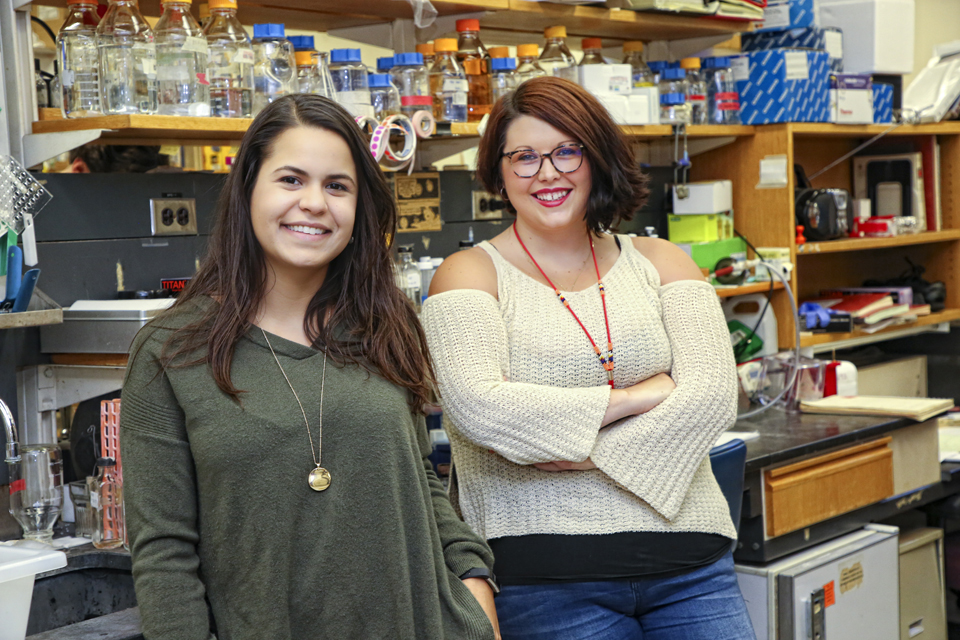Haber Lab Research

Graduate students Brenda Lemos (left) and Daneille Gallagher ask which proteins are involved in double strand breaks in DNA.
Brenda Lemos and Danielle Gallagher, Haber Lab
Office of the Vice Provost for Research: I was so happy to meet you at the Alan Alda Center for Communicating Science training, Brenda. Do you have any feedback?
Brenda Lemos: I’m very happy with the Alda training. It brought people from different parts of campus together, I don’t even know half the campus; we’re kind of in a bubble in Shapiro and Rosenstiel. We take our science knowledge for granted, and it was really good for the Alda trainers to explain to us what the general knowledge of science is in the general population. It makes me more aware when talking to the public about science and makes me want to educate people more. After I get my PhD, I hope to fill a role that will include communicating science to the public, perhaps as a liaison or in business development in pharma.
OVPR: What do you do in the Haber lab?
Danielle: You get breaks in your DNA all the time: from being in the sun, from things you eat, and that damage is similar to damage that we can create in the lab, it’s called a double strand break, which is the most toxic type of DNA damage to your cells. This is troubling because your body has to work really hard to repair those two strand breaks or else cells will die. One of the ultimate things that can arise due to this double strand break is cancer. We’re looking at how that double strand break is repaired and how the cell goes about fixing the breaks. We’re hoping to identify the proteins that are involved, because most of it is dependent on different proteins, like RAD51. To induce breaks in a simpler way we use CRISPR-Cas9 and we target breaks to somewhere in the DNA that we know about. I look at the other proteins that come in to help repair the breaks, at what they are doing to stich the DNA back together so the cell can survive.
OVPR: Tell me about CRISPR-Cas9.
Brenda: CRISPR stands for Clustered Regularly Interspaced Short Palindromic Repeats. CRISPR-Cas9 was adapted from a bacterial immune response. Bacterium have a way to insert short sequences of viral DNA into their own genome, so the next time they are targeted by the virus they can create breaks in the viral genome so it doesn’t proliferate.
OVPR: How will this work?
Brenda: What we know from cancer is that it has many different causes. DNA damage is one way cancer can arise and within a genome DNA breaks occur at different locations. DNA breaks can give rise to different mutations. In our research we are working at a very basic level to understand what is going on at a site of damage, and perhaps if we can identify which proteins are involved and describe how they work, down the line perhaps they can be used in applied research. Bottom-line, you need basic research in order to have applied research.
OVPR: What do you want us to remember about this research?
Brenda: I would like people to remember that we can’t fix your diseases without first really understanding them at a basic level, so I’d hope people understand why it’s important to support basic science. I also think there’s a responsibility for understanding basic things. There are fundamental things that scientists can communicate better but I think the population also needs to take some responsibility.
Danielle: I wish people would understand the time that goes into science and how much effort it actually takes to figure these things out. Even after we figure it out at a basic level, we have to translate to humans. We work in these simple model systems but then need to apply what we learn to humans.
OVPR: How is Brandeis’ approach different from what the other schools that are working on this are doing?
Brenda: Most labs use CRISPR Cas9. In order to see how a protein works in a system, it’s easier to eliminate the protein from the system and see the effects. People use Cas9 all the time to take genes out of from a system or make modifications to existing genes, however we still don’t understand a lot of what is involved in how it creates a break and how the break is repaired. And so Brandeis’ approach is different because we’re doing what Jim Haber has been known for throughout his career: using yeast to study DNA damage and repair in the context of Cas9.